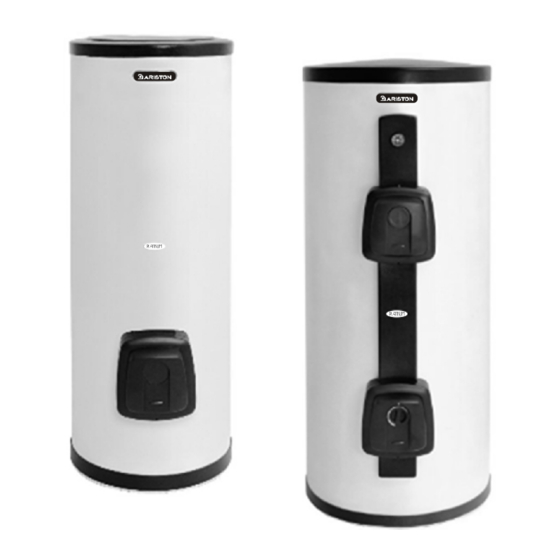Ariston 506458 Manuel - Sayfa 16
Su Isıtıcı Ariston 506458 için çevrimiçi göz atın veya pdf Manuel indirin. Ariston 506458 25 sayfaları.

To work on the thermostat (T fig.5), it is necessary to slide it out of its seat.
To work on the heating element or on the anode, you first have to empty the appliance, loosen
the 5 screws (C fig.6) and remove the flange (F fig.6).
The resistance and the anode are combined with the flange. When you reassemble the appli-
ance, make sure that the seals for the flange, the thermostat and the heating element are the
original ones (fig. 6)
We recommend you replace the seal each time you remove the flange.
(Z fig.7).
Periodic maintenance
The following operations should be performed at the end of each year of operation:
- empty the appliance and remove the flange;
- carefully remove all limescale from the heating element par ts (R fig.7); if you prefer
not to use acids designed especially for this purpose, use non-metallic objects to
break off the limescale crust that has formed, taking care not to damage the heating
element's armour.
- check the condition of the anode (N fig.7 - on the models where it is installed); it
tends to progressively wear according to the quantity of the distributed water and
prevents the boiler corrosion;
- replace the anode when its volume is 50% lower than its original volume.
- we recommend you replace the seal each time you remove the flange (Z fig.7).
To reassemble the 5-bolt flange (C fig.6), make sure the nuts are tightened properly. The bolts
must be cross-tightened.
USER INSTRUCTIONS
ATTENZIONE! Seguire scrupolosamente le avvertenze generali e le
! ! ! ! !
n o r m e d i s i c u r e z z a e l e n c a t e a l l ' i n i z i o d e l t e s t o , a t t e n e n d o s i
obbligatoriamente a quanto indicato.
Advice for the user
- Avoid positioning any objects and/or appliances that could be damaged by water leaks
beneath the water heater.
- Should you not use any water for an extended period of time, you should:
disconnect the appliance from the electrical supply by switching the external
switch to "OFF";
turn off the hydraulic circuit taps.
- Hot water at above 50°C flowing out of the taps at the point of use could cause serious
scalds or even death from burns. Children, the disabled and the elderly are more ex-
posed to the risk of burns.
- This appliance may generate hydrogen gas, if not used for more than 2 weeks. This
type of gas is highly flammable. To reduce the damage that might be caused by such
a situation, the following is recommended:
29
keep the hot water tap open for a few minutes before using any electric household
appliance;
do not smoke in the vicinity of the point of use;
do not light free flames or gas hob flames near the point of use.
However water must be drained from a tap connected to the appliance at least every 3
months, thus preventing any hydrogen gas build up.
- It is strictly forbidden for the user to perform any routine or extraordinary mainte-
nance on the appliance.
! ! ! ! !
See warning nos. 1, 2, 3
See warning no. 4 – Contact qualified staff for the replacement of the power
! ! ! ! !
supply cable.
See warning nos. 5, 6, 8
! ! ! ! !
See warning no. 21 - To clean the outer par ts of the appliance, use a damp cloth
! ! ! ! !
soaked in soapy water.
! ! ! ! !
See warning nos. 22, 23
Operation
The water heater is switched on by means of the external bipolar switch.
The pilot lamp (10 fig. 1,2,3) stays on only during the heating phase.
The thermostat will automatically disable the heating element as soon as the se-
lected water temperature is reached.
In the models where the thermometer is present, it provides a general indication of
the water temperature.
During the final stage of heating, it is normal for a few cycles of thermostat star ting
and stopping to take place.
During normal operation, the electric heating element may make a little noise in-
side the appliance, which is due to the heat exchange; the hydraulic connections
may also become hot to the touch.
Adjusting the operating temperature
For the models with external adjustment, the water temperature may be regulated
using the knob (6 fig.1,2,3) connected to the thermostat.
Turn the knob to increase or decrease the working temperature, by following the
reference marks located on the knob or the cap.
We recommend you set the temperature of the water heater to 60°C to:
- reduce the formation of limescale;
- reduce heat dispersion;
- avoid the risk of bacteria proliferation.
Resetting the bipolar safety
In the event of an abnormal overheating of the water, a thermal safety switch in compliance
with CEI-EN norms cuts off the electrical circuit on the power supply phases of the
heating element; in this case, call the After-sales service centre for assistance.
30
